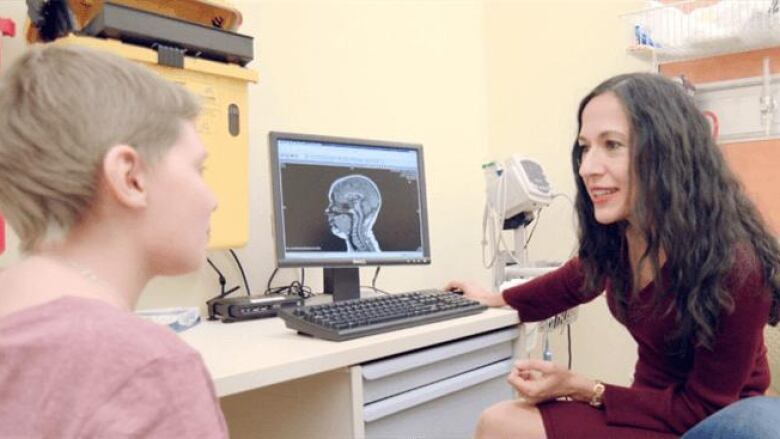Late diagnosis of tumours in children collateral damage of COVID-19, doctors say
Lack of in-person visits with family doctor a factor in diagnosis, treatment delays

Dr. Sheila Singh is used to explaining complex medical situations in simple terms. The pediatric neurosurgeon at McMaster Children's Hospital in Hamilton says that lately, she's seeing too many oranges and grapefruitsand fewer ping pong balls.
That's not good, and it could signal that the COVID-19 pandemic has delayed the diagnosis of many pediatric diseases, sometimes with devastating results.
"You can imagine a tumour that's the size of a ping pong ball, it's easier for me to work around and remove it," she said. "But if that ping pong ball-sized tumour grows to the size of an orange or a grapefruit, the tumour has grown to a size where it's much more difficult now to deal with."
Singh told Dr. Brian Goldman, host of White Coat Black Art, that she is now seeing two to three times more oranges and grapefruits than before the pandemic. In other words, the tumours have been left to grow much longer due to delays in diagnosis.
Singh saysshe believes the delays in diagnosis have been caused by patients staying away from hospitals because:
- They are afraid of catching COVID-19.
- There is a lack of in-person visits with their family doctor.
- There is an anchor bias to look for COVID-19 symptoms to the detriment of flagging other serious diseases.
"There's no doubt there will be collateral damage," she said, "and some of that will be death and poor outcomes from diseases that could have had better outcomes."
Singh saysshe remembered a recent patient, a young girl who had a tumour that typically grows in one place in the brain."This little girl came in and this tumour was actually in four places in her brain. And let me put it this way, two out of those four places I'd never seen this brain tumour in before." Instead of doing one surgery, Singh had to do several risky and difficult operations.
As a pediatric doctor, Singh says that it has been heartbreaking to see some of the children whose cancers have progressed much further than the pre-pandemic norm."I feel like I've been practising in a Third World country. I have seen disease that has spread so far that it's almost like cases I've read about in rural India. It's been quite difficult and alarming."
Pediatric cancer specialists at CHEO, formerly the Children's Hospital of Eastern Ontario, in Ottawa also saw fewer patients coming in the early days of the pandemic, when parents said they feared going to the hospital.

Early signs of widespread diagnosis delays
Early research suggests that later diagnosis of illness in children due to the pandemic may extend to other serious illnesses, not just cancer. In a study published earlier this year in the medical journal Pediatric Diabetes, researchers in Alberta found that more children are being treated for diabetic ketoacidosis, a serious and potentially fatal complication of diabetes.
The authors suggest that parents may have been reluctant to access medical services because of fear of COVID-19 and that "increased virtual visits resulted in reduced face-to-face contact with health-care providers and may have contributed to the under-recognition of the severity of illness."

Dr. Patrick McDonald says he remembers the challenges of the lockdowns. For much of the pandemic, McDonald headed up the pediatric neurosurgery division at B.C. Children's Hospital in Vancouver. In the early days of COVID-19, "I think all of us struggled with the issue [of]how do we make sure that families know that they can still access care. It might be a little more challenging, and we might have to do it initially by phone."
He saidthat "it's a legitimate concern that people might not be able to or might not be accessing care in a timely fashion."
Push for more in-person care
In October, the Ontario Ministry of Health and the College of Physicians and Surgeons ofOntario issued a letter that encouraged doctors to resume in-patient visits over virtual appointments.
"The standard of care is often difficult to meet in a virtual care environment," the letter stated."In-person care is essential for certain conditions and services or where physical assessments are necessary to make an appropriate diagnosis or treatment decision."

That's particularly true when examining a young patient, Singh stressed. "There's so much room to miss a diagnosis when you're staring at a child on a screen."
One of the common symptoms of a brain tumour in a child is macrocephaly, a technical term for an enlarged head, which Singh said can be a challenge to identify during a virtual visit.
"Depending on the angle at which you're looking at a child, you might not even notice how big their head is or even be alarmed about it, whereas if that child walked into a room, it'd be the first thing you'd notice about them."
McDonald says he believes that it may be another year before the full impact of delayed diagnosis due to COVID-19 is really understood. When the data does emerge, he stressed that we need to carefully examine what happened to understand why people may not have sought out the care their children needed.
"There may be another pandemic, and we want to make sure that we learn appropriate lessons for what we did right and what we did wrong in providing adequate care," he said.
In the meantime, Singh offered two pieces of advice to parents. First, she said, "It's safe to go to your hospital." And second, "I would really encourage parents not to accept a virtual visit as being a proper way to diagnose your child."
Singh stressedthat when parents are concerned about their child, an in-person physical examination is imperative to receive a proper diagnosis.
Written and produced by Jeff Goodes, with files from Amina Zafar












_(720p).jpg)


 OFFICIAL HD MUSIC VIDEO.jpg)
.jpg)



























































































